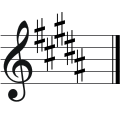B major
B major is a key of the major genre, based on the root note B. The key of B major is written in musical notation with five crosses (F sharp, C sharp, G sharp, D sharp, A sharp). The corresponding scale and the fundamental chord of this key (the tonic b-d sharp-f sharp) are also designated by the term B major.

![]()
![]()
![]()
![]()
![]()
![]()
![]()
![]()
![]()
![]()
![]()
![]()
![]()
![]()
![]()
B major is often described as bright and radiant, but see the article Key Character.
Key classification
| Keys and their accidentals | |||||||||||||||
| Portent: | 7 ♭ | 6 ♭ | 5 ♭ | 4 ♭ | 3 ♭ | 2 ♭ | 1 ♭ | 0 ♭/♯ | 1 ♯ | 2 ♯ | 3 ♯ | 4 ♯ | 5 ♯ | 6 ♯ | 7 ♯ |
| Major keys: | Ces | Ges | Des | As | It | B | F | C | G | D | A | E | H | F# | C sharp |
| Minor keys: | as | it | b | f | c | g | d | a | e | h | F# | cis | gis | dis | ais |
Questions and Answers
Q: What is B major?
A: B major is a major scale based on the note B.
Q: How many sharps are in the key signature for B major?
A: The key signature for B major has five sharps.
Q: What is the relative minor of B major?
A: The relative minor of B major is G-sharp minor.
Q: What is the parallel minor of B major?
A: The parallel minor of B major is B minor.
Q: What instrument's home key does C-flat Major correspond to?
A: C-flat Major corresponds to the harp's home key.
Q: Why did Frédéric Chopin think that playing in the key of B Major was easy?
A: Frédéric Chopin thought that playing in the key of B Major was easy because its black notes fit well with natural positions of fingers when playing piano.
Q: Why did he teach students this scale first, before teaching them how to play in C Major?
A: He taught students this scale first because he thought it was easier than C Major and wanted to make sight reading easier by having both staves look similar when playing piano music.
Search within the encyclopedia














